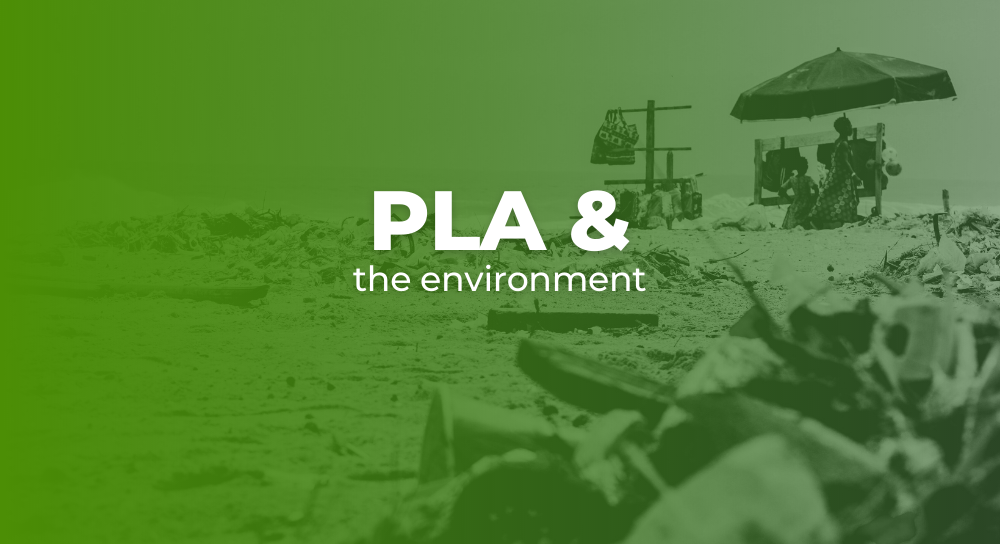
Since the 1950s, the global population has generated almost nine billion tonnes of plastic. Much of this pollutes our oceans, 165 million tonnes, with an additional 9 million tonnes arriving each year. Because only around 9% of plastic is recycled, the majority of this waste ends up in oceans or in landfills, where it can take up to 500 years to degrade while releasing harmful chemicals.
Plastics in the past were created from petroleum-based materials. Some argue that bioplastics, which are made up of at least 20% renewable elements, might be the answer to plastic pollution. Bioplastic has a number of advantages, including less content derived from fossil fuels and speedier disintegration. Bioplastic is also less harmful than standard plastics since it does not include bisphenol A (BPA), a hormone disrupter present in many common plastics.
PLA (polylactic acid) is a thermoplastic monomer derived from organic materials such as maize starch or sugar cane. PLA is different from traditional plastics in that it is manufactured from biomass rather than fossil fuels via petroleum distillation and polymerisation.
Despite the differences in fundamental components, PLA can be produced using the same equipment as petrochemical plastics, making PLA manufacturing processes relatively cost-effective. PLA is the second most widely made bioplastic in the world, behind thermoplastic starch.
Since its invention in the 1920s, PLA has been widely employed in a number of commercial and industrial applications. PLA’s ability to replace polythene (used in plastic films, packaging, and bottles), polystyrene (used in Styrofoam and plastic cutlery), and polypropylene (used in plastic cutlery, packaging, auto parts, and textiles) set it apart from the competition.
In 2010, researchers from the University of Pittsburg discovered that the manufacture of bioplastics resulted in higher levels of pollution. This was due to the use of fertilisers and pesticides in the cultivation of the crops, as well as the chemical processing required to convert organic material to plastic. Bioplastics also caused greater ozone depletion than ordinary plastics and necessitated a large amount of land use. Given that both agriculture and chemical processing generate negative effects, B-PET, the hybrid plastic, was determined to have the highest potential for hazardous effects on ecosystems as well as producing the most carcinogens. B-PET scored the poorest in the life cycle study.
Biodegradable polymers are frequently touted as more environmentally friendly and sustainable. These claims are unsubstantiated and deceptive. Not only are certain biodegradable plastics created from fossil fuels or include toxic chemicals in their manufacturing, but their whole lifespan, from manufacturing to disposal, is damaging to the environment.
The issue with biodegradable plastics is that they are known to produce minute pieces called microplastics, which can ultimately find their way up the food chain and reach us, humans, while also destroying a staggering number of animal life each year, culminating in disastrous environmental impact.
Because biodegradable plastics are derived from or require the use of oil, they contribute to the depletion of a finite fossil energy source. At all phases of manufacturing, fossil fuel extraction and the plastic industry are correlated to climate change and considerable pollution. They have been discovered to pollute land, water, and air with compounds that are hazardous to all living species, including humans.
When these items end up in recycling streams, they cause challenges for recyclers as well. Many bioplastics have biodegradable ingredients which create issues when the plastic is recycled and used again and again. Carpeting, geotextiles, strapping, plastic lumber, and pipe all use a lot of recycled plastic. These products are designed for long-term applications. Some of these goods are intended to last for 30 years or more. What happens if the polymer molecules degrade before the intended service life is reached? Failure and potentially costly cleanup is a likely results.
When all aspects of their life cycle are considered, it’s difficult to say that bioplastics are more environmentally friendly than traditional plastics: land use, pesticides and herbicides, energy consumption, water consumption, greenhouse gases and methane emissions, biodegradability, recyclability, and more – if anything, they’re just as bad as plastics. Bioplastics offer potential to help decrease plastic waste and our carbon footprint as researchers across the world try to produce greener kinds and more efficient manufacturing techniques, but that bioplastic is not PLA.
PO Box 598 Nambour QLD 4560 Australia